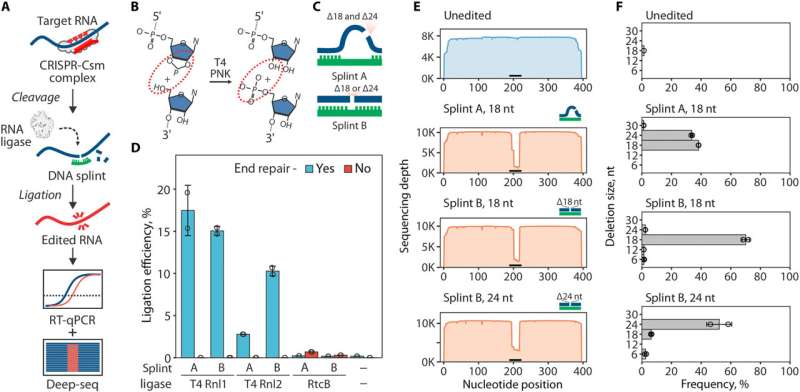September 29, 2023 report
This article has been reviewed according to Science X's editorial process and policies. Editors have highlighted the following attributes while ensuring the content's credibility:
fact-checked
peer-reviewed publication
trusted source
proofread
Using a cutting enzyme and an RNA repair enzyme to modify RNA virus genomes

A team of microbiologists at Montana State University has developed a way to use a cutting enzyme and an RNA repair enzyme to modify the genome of an RNA virus. They describe their technique in Science Advances.
Over the past decade, clustered regularly interspaced short palindromic repeats (CRISPR) gene-editing tools have been developed that allow the editing of DNA. The process works by using RNA sequences to find a desired target in a DNA strand and then using a certain type of protein to cut the sequence. The system was developed after the discovery that bacteria and archaea use it to edit the DNA of viral enemies.
More recently, scientists have been attempting to use the same or a similar technique to edit RNA. Most current approaches involve transcribing RNA into DNA, making edits, and then transcribing them back into RNA. The Montana State researchers have been seeking a more direct approach.
The new approach involves use of a type III CRISPR system taken from Streptococcus thermophilus, a type of bacteria found in dairy products. It is used to find the place in a target RNA where cutting is desired. Once the target has been cut, DNA splints are used to draw the dangling strands back together, where they are rejoined using a viral ligase enzyme.
To test their process, the team made desired deletions in the RNA of a Sindbis virus. It was chosen because it has a green fluorescent segment in its RNA. Cutting it out allowed the virus to survive, but it was no longer fluorescent.
The research team suggests that their technique, or others like it, could be used to conduct RNA research efforts, particularly those involving gain or loss of function in viruses, such as virulence. They note it could also be used to take out functions in a virus that allow it to circumvent drugs used to kill it. They also point out that the ability to edit RNA opens the door to new types of therapies for treating RNA-based disorders.
More information: Artem Nemudryi et al, CRISPR-based engineering of RNA viruses, Science Advances (2023). DOI: 10.1126/sciadv.adj8277
Journal information: Science Advances
© 2023 Science X Network




















